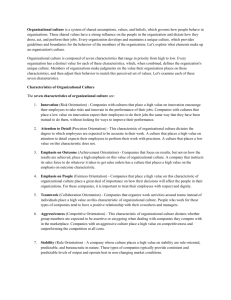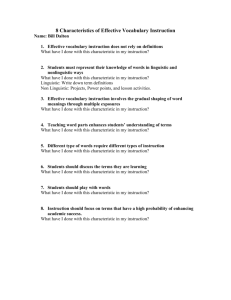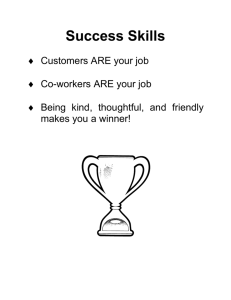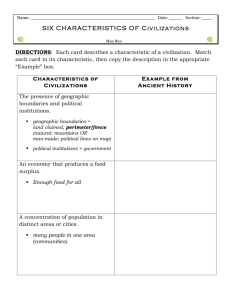THE 8 CHARACTERISTICS OF HEALTHY RELATIONSHIPS By
advertisement
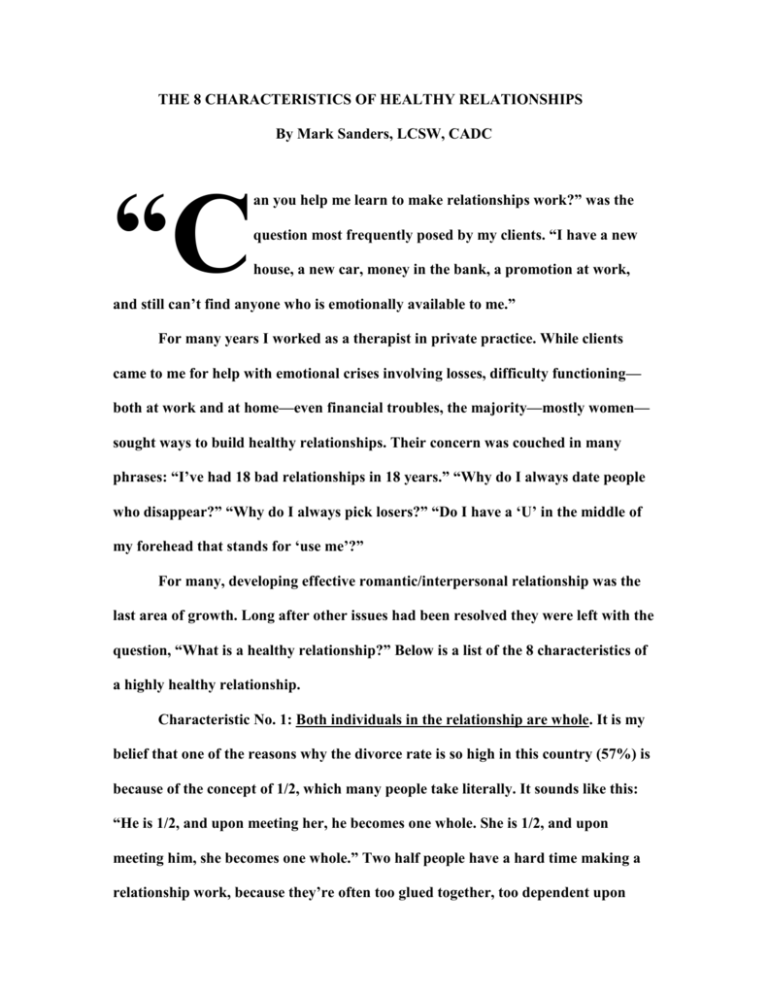
THE 8 CHARACTERISTICS OF HEALTHY RELATIONSHIPS By Mark Sanders, LCSW, CADC “C an you help me learn to make relationships work?” was the question most frequently posed by my clients. “I have a new house, a new car, money in the bank, a promotion at work, and still can‟t find anyone who is emotionally available to me.” For many years I worked as a therapist in private practice. While clients came to me for help with emotional crises involving losses, difficulty functioning— both at work and at home—even financial troubles, the majority—mostly women— sought ways to build healthy relationships. Their concern was couched in many phrases: “I‟ve had 18 bad relationships in 18 years.” “Why do I always date people who disappear?” “Why do I always pick losers?” “Do I have a „U‟ in the middle of my forehead that stands for „use me‟?” For many, developing effective romantic/interpersonal relationship was the last area of growth. Long after other issues had been resolved they were left with the question, “What is a healthy relationship?” Below is a list of the 8 characteristics of a highly healthy relationship. Characteristic No. 1: Both individuals in the relationship are whole. It is my belief that one of the reasons why the divorce rate is so high in this country (57%) is because of the concept of 1/2, which many people take literally. It sounds like this: “He is 1/2, and upon meeting her, he becomes one whole. She is 1/2, and upon meeting him, she becomes one whole.” Two half people have a hard time making a relationship work, because they‟re often too glued together, too dependent upon 2 each other, or too addicted to the other. Relationships would have a greater chance of succeeding if two whole people entered them. Below are two practices for developing wholeness: A. Have a relationship with yourself. This can be manifested by spending regular time alone. Many of the single women with whom I worked stated that they never went to a movie alone, ate dinner alone, went to a museum alone; some never even shopped for themselves in a grocery store for items chosen particularly for themselves. Treating oneself right affirms the fact that one deserves to be treated right in all relationships. If you have a relationship with self, you will be less likely to look for a person who does not have a relationship with self, i.e., a half person, to form a union with. Also, the cliché, “You can‟t live with someone unless you know you can live without them” is true. Having a relationship with oneself is the greatest assurance that you can live without someone else. B. Develop a spiritual life. Minus this, many people turn their partners into God. At that point, the relationship is doomed to fail! It is often important for people to strengthen their spiritual lives while in a relationship. Characteristic No. 2: Each partner is growing and encouraging the other to grow. Effective relationships involve continued growth—for both partners, even if it takes them into divergent areas. Many clients would tell stories of their reluctance to pursue their dreams, fearing that their partners would leave them if they embarked on a growth path. Some even told stories of their partners actually disappearing as 3 soon as they started to achieve their goals, then returning when they gave the goals up. It is important to go for the goals anyway. One way of doing this is to surround yourself with others, i.e., friends, mentors, support groups, etc., who are goal directed. This should give you the balance that is often needed if you‟re not receiving support from a partner. The reality is that sometimes relationships end when one person is growing and the other is not. The good news is that, as you continue to grow, you‟re in a position to perhaps attract partners in your life who are also on a growth path. As the saying goes, “Like attracts like.” Characteristic No. 3: Each has a separate life outside of the relationship. This includes activities in which they engage with friends, sporting events they watch or participate in, hobbies, or other interests they pursue. Time away from each other gives them the space that all relationships need. It can also add excitement when they are reunited. Characteristic No 4: The relationship does not have too much jealousy. I once heard Maya Angelou say, “Jealousy is like salt. A little salt spices up the food, but too much salt can destroy the food.” Jealously in relationships seems to work the same way. This illustrates the importance of having separate lives outside the relationship (Characteristic No 3). This can help each partner spend less time focused on jealous thoughts. It also illustrates the importance of having a spiritual life (Characteristic No 2). By focusing on your internal world, your higher power, or your purpose for being, you have less time to be jealous. Characteristic No. 5: The couple is able to argue in the present. Resentments have probably destroyed more relationships than any other human emotion. 4 Resentments in relationships are often caused by holding things inside that bug you, irk you, or anger you slightly, letting them pile up, and then exploding. You can tell when your arguments with your partner are wrought with resentment, because you usually argue about several things at once and/or use events from the past as ammunition during your fights. One way to learn how to argue in the present is to have a mechanism to release your anger regularly. This can involve journaling, talking to a counselor regularly or a close friend who really listens, and making a commitment to yourself and to your partner to try to argue in the present. Characteristic No. 6: The absence of all abuse. That includes physical, sexual, mental, emotional, and verbal abuse. We have learned that abuse in relationships is often progressive. A partner who hits you once will almost always become more abusive later. The exciting news is that if you have developed a relationship with yourself (Characteristic No. 1), nurture your spiritual life (Characteristic No 2), and have a support network outside of your relationship (Characteristic No. 3), you will have the insight to avoid abusive relationships and the strength to leave one if it‟s already abusive. Characteristic No. 7: There is absence of strings attached to giving. Many of my clients reported being in relationships that were conditionally loving. This pattern is often traced to early childhood experiences in which the clients were loved, “if they were „good‟”; “if they made good grades”; “if they made their parents proud.” If they failed in these arenas, love was often pulled away. As adults, many clients mentioned being in relationships in which gifts were used as control, as was sex. Withholding love was again used as a form of control. In relationships in 5 which giving is used as a form of control and in which giving is conditional, you often hear the phrase, “How could you do that, after all I‟ve done for you?” There‟s little freedom in such a relationship. One way to assure that you‟re giving has no strings attached is to ask yourself, “What is my motive in my giving?” If it is done to make your partner dependent upon you or to feel indebted to you, it is not unconditional. Characteristic No. 8: The partners are gentle with themselves as they develop new relationship skills. My most common finding was that clients who had patterns of unhealthy relationships came from families that did not mirror super-healthy relationships. If you didn‟t see it, how do you know what it looks like? This can take years to discover. The phrase, “We seek progress rather than perfection,” which is common in the twelve-step literature of such groups as Alcoholics Anonymous, can be applied when individuals are learning to have healthy relationships. It is my belief that one of the purposes of relationships is to teach us lessons. People tend to repeat patterns until they learn the lesson that the relationship is there to teach them. If you learn the lesson, there is no such thing as a failed relationship. Some people give up on their partners and make statements such as, “I‟m not going to try to fix this particular relationship, because „you can‟t teach an old dog new tricks.‟” Thank goodness people aren‟t dogs. People are capable of change at any age. The reality is that the only person you can change is yourself. Even if your partner does not change, you can still seek joy in your own progress. 6 ABOUT THE AUTHOR Mark Sanders, LCSW, CADC, is a member of the faculty of the Addictions Studies Program at Governors State University. He is an international speaker in the addictions field whose presentations have reached thousands throughout the United States, Europe, Canada, and the Caribbean Islands. He is co-author of Recovery Management and Relationship Detox: How To Have Healthy Relationships in Recovery. Mark can be reached at onthemark25@aol.com


